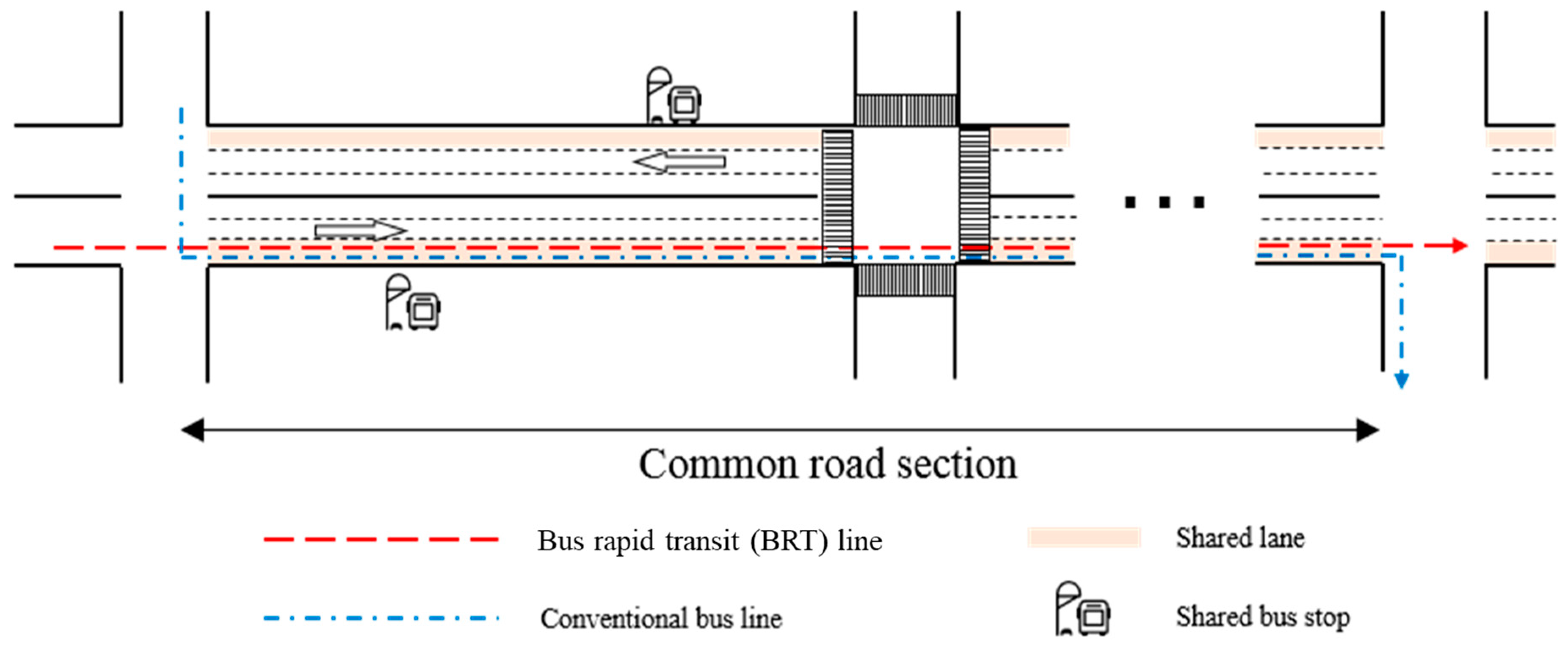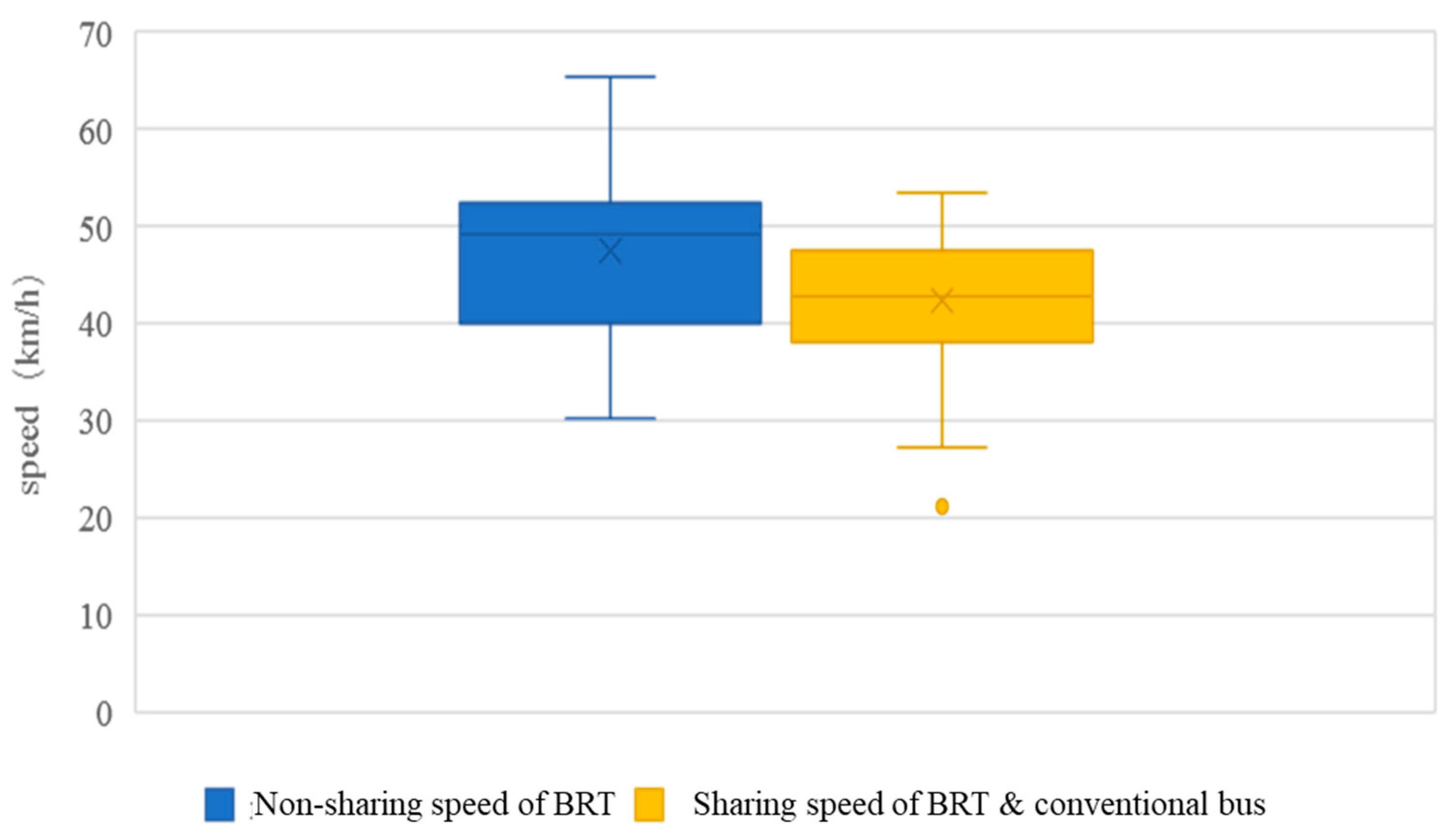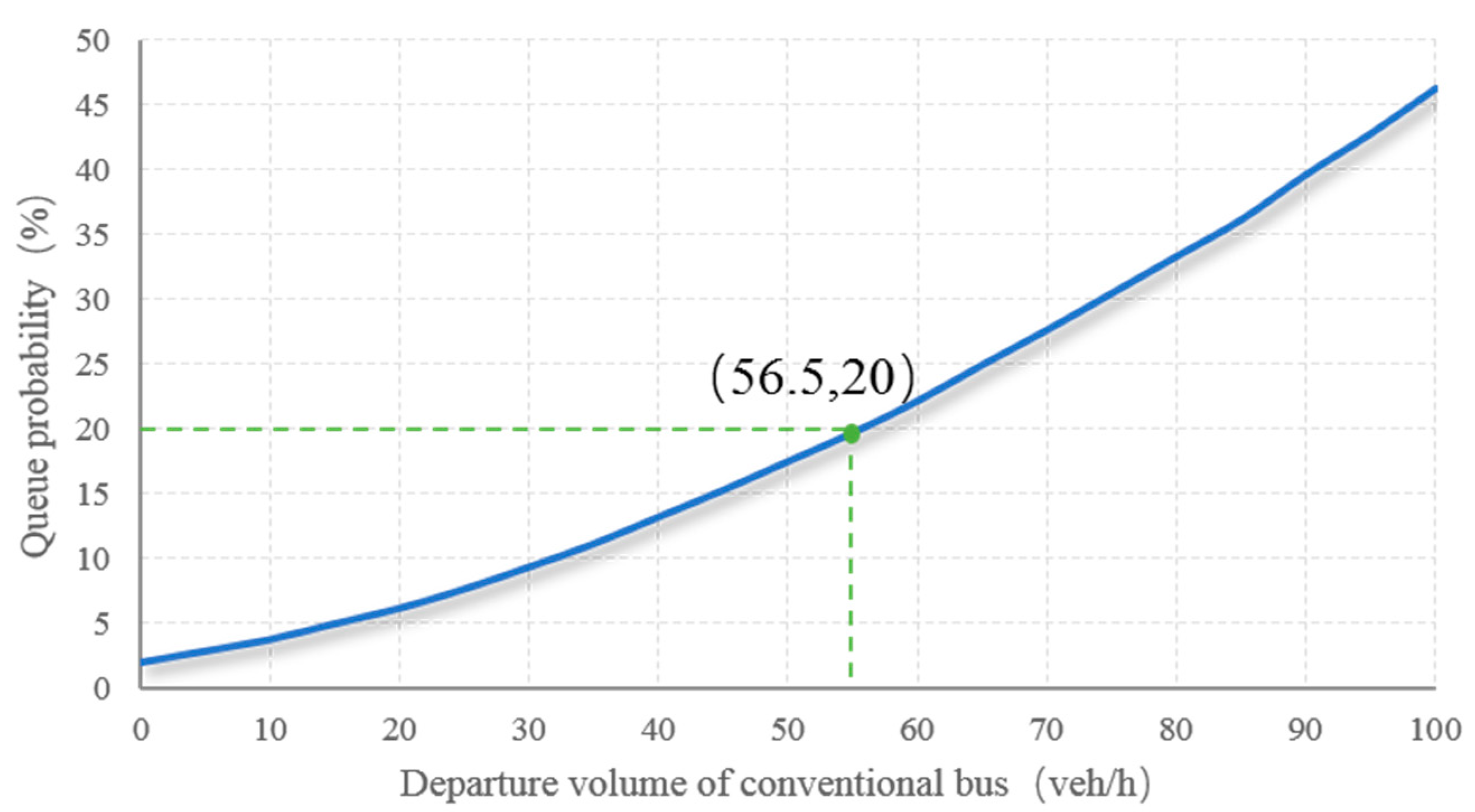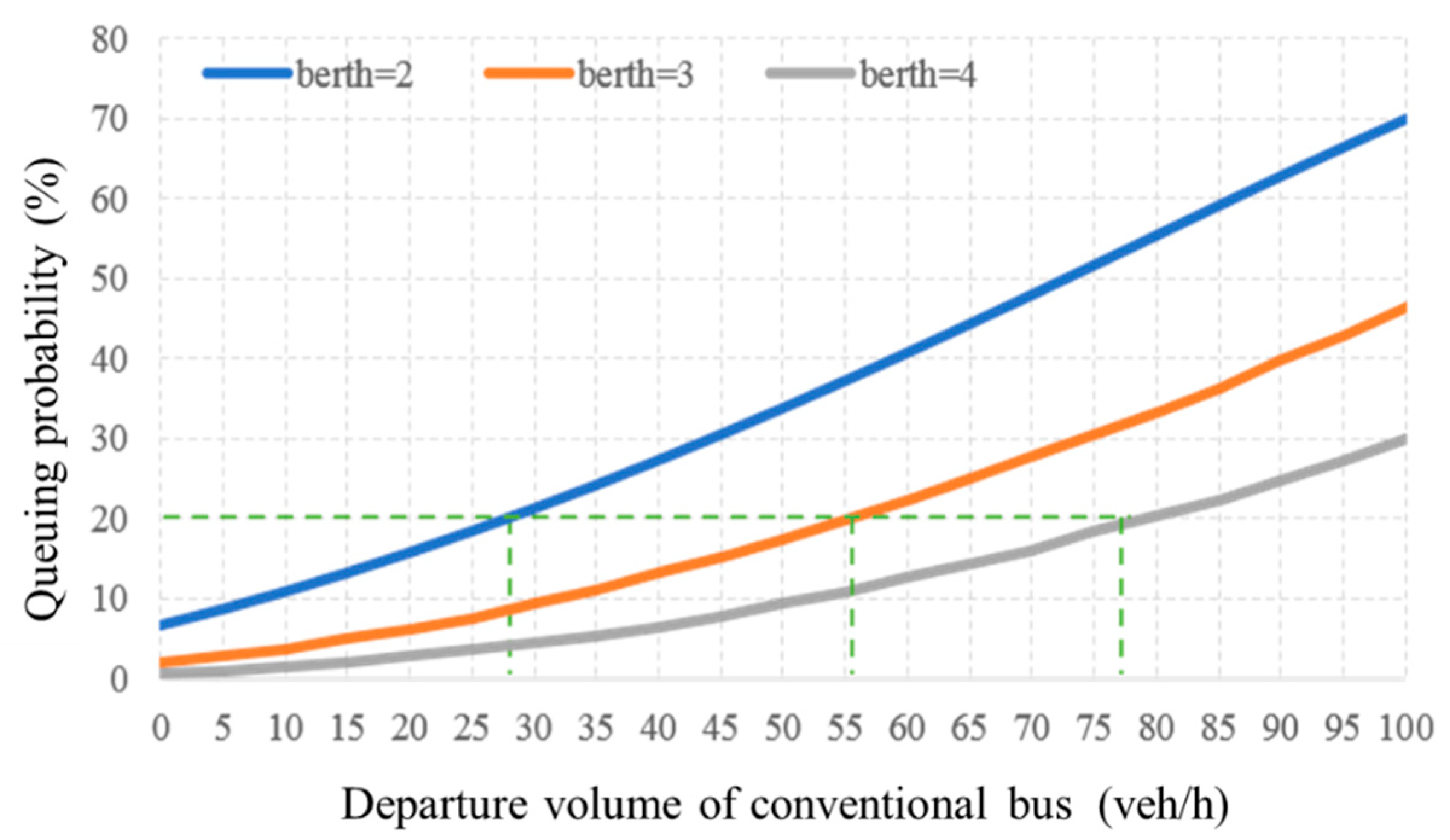Threshold Determination for Sharing Bus Rapid Transit–Exclusive Lanes with Conventional Buses
Abstract
:1. Introduction
2. Shared Influencing Factors and Analytical Models
2.1. Sharing BRT-Exclusive Lane with Conventional Bus Survey
2.1.1. Analysis of Shared Influencing Factors
2.1.2. Survey Scheme Design
2.2. Analytical Models
2.2.1. Analysis of Speed and Flow-Speed Model
- : The traffic flow;
- : The undetermined coefficients.
- : The free travel time;
- : The free flow speed;
- : The road capacity;
- : The undetermined coefficients, the other symbols are the same as before.
2.2.2. Delay Analytical Model
2.2.3. Analysis of Queuing and M/M/n Model
- : The arrival rates of BRT and conventional buses respectively;
- : The average service time of BRT and conventional buses respectively;
- : The arrival rate of equivalent bus flow;
- : The average service time of equivalent bus flow;
- : The average service rate of equivalent bus flow;
- : The service intensity of the system;
- : The number of berths at shared stations;
- : The idle probability of service berth.
3. Sharing Threshold Determination Method
3.1. Sharing Threshold Index
3.2. Sharing Threshold Constranits
3.2.1. The Operation Efficiency of Road Section
- : The efficiency priority coefficient;
- : The per capita travel time after sharing;
- : The per capita travel time before sharing.
- : The BRT flow;
- : The conventional bus flow;
- : The car flow;
- : The travel time of vehicles on BRT lane before sharing;
- : The travel time of vehicles on social driveway before sharing;
- : The travel time of vehicles on BRT lane after sharing;
- : The travel time of vehicles on social driveway after sharing;
- : The passenger volume of BRT;
- : The passenger volume of conventional buses;
- : The passenger volume of cars.
3.2.2. The Queuing Probability
- : The queuing probability at shared stop;
- : The maximum allowable queuing probability, 10–25% is usually suggested.
3.2.3. The Operation Time
- : The length of the shared section;
- : The delay of all stops after sharing;
- : The delay of all intersections after sharing;
- : The operation time of vehicles on BRT lane after sharing;
- : The average delay of each stop after sharing;
- : The average delay of each intersection after sharing;
- : The number of stops on shared section;
- : The number of intersections on shared section;
- : The speed of vehicles on shared section;
- : The speed of BRT at lowest level of service.
3.3. Sharing Threshold Interval
4. Numerical Examples
4.1. Indicator Values
4.2. Calculation of Lower Limit
4.3. Calculation of Upper Limit
4.3.1. Upper Limit Constrained by Queuing Probability
4.3.2. Upper Limit Constrained by Operation Time
4.4. Results of Scenarios
- Under each scenario above, threshold within the number of berths ranging from 2–4 were compared. The more berths are, the bigger upper limit is and the larger interval of threshold is. In practical engineering applications, it is possible to improve traffic conditions, like increasing the number of berths, which can expand the shared threshold interval, so that there will be a higher possibility of sharing implementation.
- When the spacing of intersections and stops is not so large (scenario 1, 2), the value under the operation time constraint is smaller than that calculated by queuing probability constraint, which determines the upper limit of threshold. When the spacing is small, a greater delay will be caused during the process of deceleration, approaching, stopping, acceleration, and leaving at the bus stop or intersection.
- With the spacing of stops and intersections reasonably improved (scenario 3), the operation time becomes the constraint of the maximum of conventional buses that can be introduced into exclusive bus lanes.
5. Conclusions
Author Contributions
Funding
Conflicts of Interest
References
- China M.O.T.O. 2016 Statistical Bulletin of the Development of the Transportation Industry, Finance & Accounting for Communications. Heavy Veh. 2017, 5, 92–97. [Google Scholar]
- Deng, T.; Nelson, J.D. Recent Developments in Bus Rapid Transit: A Review of the Literature. Transp. Rev. 2011, 31, 69–96. [Google Scholar] [CrossRef]
- Jepson, D.; Ferreira, L. Assessing travel time impacts of measures to enhance bus operations. Part II: Assessment criteria and main findings. Road. Transp. Res. 2000, 9, 3–18. [Google Scholar]
- Tiezhu, L.; Ding, J.; Sun, Y.; HE, Z. Traffic Condition for Bus Lane Setting on Urban Arteries. J. Kunming Li 2010, 35, 56–60. [Google Scholar]
- Liu, W.; Bie, M.; Zhang, J.X.; Zhu, S.Y. Study on traffic conditions for setting up bus lanes. J. Chongqing Jiaotong Univ. 2005, 24, 129–132. [Google Scholar]
- Viegas, J.; Lu, B. Widening the scope for bus priority with intermittent bus lanes. Transp. Plan. Technol. 2001, 24, 87–110. [Google Scholar] [CrossRef]
- Viegas, J.; Lu, B. Bus priority with intermittent bus lane. In Proceedings of the Seminar D, European Transportaion Conference, Cambridge, UK, 27–29 September 1999. [Google Scholar]
- Duerr, P.A. Dynamic Right-of-Way for Transit Vehicles: Integrated Modeling Approach for Optimizing Signal Control on Mixed Traffic Arterials. Transp. Res. Rec. J. Transp. Res. Board 2000, 1731, 31–39. [Google Scholar] [CrossRef]
- Janos, M.; Furth, P. Bus priority with highly interruptible traffic signal control: Simulation of San Juan’s Avenida ponce de leon. Transp. Res. Rec. J. Transp. Res. Board 2002, 1811, 157–165. [Google Scholar] [CrossRef]
- Lin, W.H. Quantifying Delay Reduction to Buses with Signal Priority Treatment in Mixed-Mode Operation. Transp. Res. Rec. J. Transp. Res. Board 2002, 1811, 100–106. [Google Scholar] [CrossRef]
- Feng, S.; Dian-Hai, W.; Dong-Fang, M.A.; Sheng, J. Threshold values of traffic flow for the provision of exclusive. J. Beijing Inst. Technol. 2013, 22, 342–349. [Google Scholar]
- Han, H. Feasibility Study of Taxi Driving on Bus Lanes; Beijing Jiaotong University: Beijing, China, 2007. [Google Scholar]
- Shalaby, A.S. Simulating performance impacts of bus lanes and supporting measures. J. Transp. Eng. 1999, 125, 390–397. [Google Scholar] [CrossRef]
- Huang, Y.J.; Chen, X.W.; Zhang, W.H. Comparison of traffic flow models on the road sections before and after the establishment of bus lanes. J. Huazhong Univ. Sci. Technol. 2003, 20, 68–70. [Google Scholar]
- Lei, L. Effects of Bus Lanes on Road Traffic; Beijing Jiaotong University: Beijing, China, 2008. [Google Scholar]
- Zhou, Z.Y.; Guang, Y.J.; Chen, J.; Wang, W. Study on the characteristics of the bus stop before and after the establishment of the dedicated bus lane. Highw. Traff. Technol. 2004, 7, 103–107. [Google Scholar]
- Vedagiri, P.; Arasan, V.T. Modelling modal shift due to the enhanced level of bus service. Transport 2009, 24, 121–128. [Google Scholar] [CrossRef]
- Basso, L.J.; Guevara, C.A.; Gschwender, A.; Fuster, M. Congestion pricing, transit subsidies and dedicated bus lanes: Efficient and practical solutions to congestion. Transp. Policy 2011, 18, 676–684. [Google Scholar] [CrossRef]
- Khoo, H.L.; Ong, G.P. Bi-Objective Optimization Approach for Exclusive Bus Lane Scheduling Design. J. Comput. Civ. Eng. 2015, 29, 04014056. [Google Scholar] [CrossRef]
- Wei, J.; Cui, Y. Reversible Lane Scheme Selection Model Based on the BPR Function and Environmental Benefits. In Proceedings of the 2nd International Conference on Materials Science, Machinery and Energy Engineering, Dalian, China, 13–14 May 2017. [Google Scholar]
- Transportation Research Board. Highway Capacity Manual 2000; National Research Council: Washington, DC, USA, 2000.
- Lipsky, L. Queuing Theory: A Linear Algebraic Approach, 2nd ed.; Springer Science+Business Media, LLC: New York, NY, USA, 2008. [Google Scholar]










| Respondents | Location | Method | Time | Data | |
|---|---|---|---|---|---|
| Road section | Shared | Yanling Middle Road | Video Survey | 2017.9.26–2017.9.28 (peak period: 7:00–9:00; 16:00–18:00); (off-peak period: 9:00–10:00; 15:00–16:00) | Speed Flow |
| Non-Shared | Dongfang West Road | ||||
| Station | Shared | People’s Park Station | Survey at Stop | 2017.9.26–2017.9.28 (peak period: 7:00–9:00; 16:00–18:00) | Arrival Time Service Time Queuing Time Boarding and Alighting |
| Non-Shared | Lihua Road-Guanhe Road Station | ||||
| Proportion of Queuing Vehicles in all Vehicles (%) | Average Queuing Time of All Vehicles (s) | Average Queuing Time of Queuing Vehicles (s) | Maximum Queuing Time of Queuing Vehicles (s) | Standard Deviation |
|---|---|---|---|---|
| 29.1% | 7.36 | 25.24 | 76 | 15.79 |
| Indicators | Assumed Value |
|---|---|
| Length of Shared Road Section, | 10 km |
| Flow of BRT, | 30 veh/h |
| Flow of Cars, | 30 veh/h |
| Average Intersection Spacing | 800 m |
| Average Stop Spacing | 800 m |
| Average Green Ratio of Intersection, | 0.6 |
| Average Service Time of BRT and Conventional Buses, | 30 s |
| The Maximum Allowable Queuing Probability, | 20% |
| The Number of Berths, | 3 |
| Passenger Volume of BRT, | 60 |
| Passenger Volume of Conventional Buses, | 30 |
| Passenger Volume of Cars, | 2 |
| Coefficient of Efficiency Priority, | 0.95 |
| Speed of BRT at Lowest Level of Service, | 20 km/h |
| Arrival Distribution of Buses | Passion Distribution |
| Flow of Cars (veh/h/ln) | Departure Volume of Conventional Buses (veh/h) | Flow of Cars (veh/h/ln) | Departure Volume of Conventional Buses (veh/h) |
|---|---|---|---|
| 200 | 101 | 450 | 14 |
| 250 | 67 | 500 | 13 |
| 300 | 42 | 550 | 11 |
| 350 | 25 | 600 | 9 |
| 400 | 16 | 650 | 7 |
| Scenario 1: Average Stop Spacing = 600 m, Average Intersection Spacing = 600 m | ||||
| Number of Berths | Lower Limit by Operation Efficiency (veh/h) | Upper Limit by Queuing Probability (veh/h) | Upper Limit by Operation Time (veh/h) | Interval of Threshold (veh/h) |
| 2 | 16 | 28 | / | / |
| 3 | 56 | 8 | / | |
| 4 | 79 | 17 | (16, 17) | |
| Scenario 2: Average Stop Spacing = 700 m, Average Intersection Spacing = 700 m | ||||
| Number of Berths | Lower Limit by Operation Efficiency (veh/h) | Upper Limit by Queuing Probability (veh/h) | Upper Limit by Operation Time (veh/h) | Interval of Threshold (veh/h) |
| 2 | 16 | 28 | 19 | (16, 19) |
| 3 | 56 | 47 | (16, 47) | |
| 4 | 79 | 63 | (13, 63) | |
| Scenario 3: Average Stop Spacing = 800m, Average Intersection Spacing = 800m | ||||
| Number of Berths | Lower Limit by Operation Efficiency (veh/h) | Upper Limit by Queuing Probability (veh/h) | Upper Limit by Operation Time (veh/h) | Interval of Threshold (veh/h) |
| 2 | 16 | 28 | 43 | (16, 28) |
| 3 | 56 | 76 | (16, 56) | |
| 4 | 79 | 122 | (16, 79) | |
© 2019 by the authors. Licensee MDPI, Basel, Switzerland. This article is an open access article distributed under the terms and conditions of the Creative Commons Attribution (CC BY) license (http://creativecommons.org/licenses/by/4.0/).
Share and Cite
Yue, Y.; Chen, J.; Yang, Q.; Ye, J. Threshold Determination for Sharing Bus Rapid Transit–Exclusive Lanes with Conventional Buses. Sustainability 2019, 11, 4592. https://doi.org/10.3390/su11174592
Yue Y, Chen J, Yang Q, Ye J. Threshold Determination for Sharing Bus Rapid Transit–Exclusive Lanes with Conventional Buses. Sustainability. 2019; 11(17):4592. https://doi.org/10.3390/su11174592
Chicago/Turabian StyleYue, Yifan, Jun Chen, Qi Yang, and Jiao Ye. 2019. "Threshold Determination for Sharing Bus Rapid Transit–Exclusive Lanes with Conventional Buses" Sustainability 11, no. 17: 4592. https://doi.org/10.3390/su11174592





